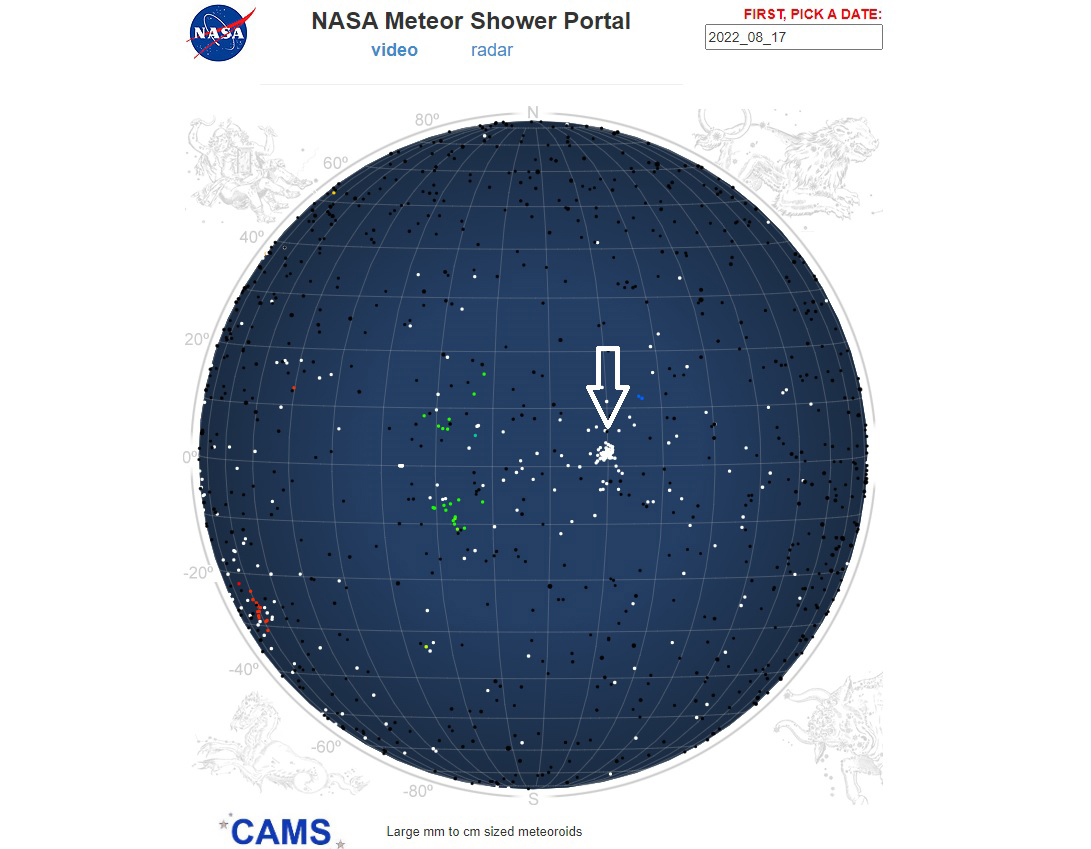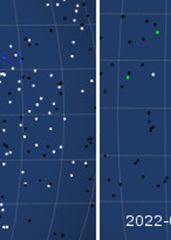Abstract: On August 16, 2022, the global CAMS low-light video camera networks detected an outburst from a mean radiant position at geocentric position R.A. = 324.7 ± 0.2 deg, Decl. = -11.6 ± 0.3 deg, in the anti-helion source, with geocentric speed Vg = 24.2 ± 0.3 km/s (Equinox J2000). The new shower received the temporary designation M2022-Q1, and likely will be called 18-Aquariids. The shower was detected first mainly by the networks in the USA and Chile. However, the shower is ongoing, and may be increasing in activity, given that the first data from August 17 also shows the shower active. The orbit has a low inclination and resembles that of comet Lexell during its return in 1770 and 1776.
INTRODUCTION
The CAMS low-light video camera networks have detected an ongoing outburst of meteors with a low inclined orbit in the anti-helion source (c.f. http://cams.seti.org/FDL/ for the date of 2022 Aug 16). Now that the IAU Commission F1 has introduced a new meteor shower designation system, which assigns a temporary name based on the time of the report, this shower is called M2022-Q1. We don’t know yet how to use such designations properly. The author preferred name is: 18-Aquariids.

OBSERVATIONS
A total of 36 meteors were triangulated between 2022 Aug. 15 20:37 and 2022 Aug. 16 12:02 UT (Jenniskens, 2022), but that does not mark the end of the shower (e.g., see http://cams.seti.org/FDL/ for the date of 2022 Aug 17). The radiant around solar longitude 143.1 deg was centered on the median geocentric position R.A. = 324.7 ± 0.2 deg, Decl. = -11.6 ± 0.3 deg, with geocentric speed Vg = 24.2 ± 0.3 km/s (Equinox J2000). This is on the border of Aquarius and Capricorn. The median orbital elements are:
- a = 3.16 AU,
- q = 0.547 ± 0.025 AU,
- e = 0.823 ± 0.069,
- i = 1.90 ± 1.30 deg,
- ω = 270.7 ± 2.3 deg,
- Ω = 143.2 ± 0.7 deg.
Perhaps coincidentally, this orbit resembles that of lost comet D/1770 L1 (Lexell) during its returns in 1770 and 1776: a = 3.15 AU, q = 0.674 AU, e = 0.786, i = 1.55 deg, ω = 225.0 deg, and Ω = 134.5 deg. Mainly the argument of perihelion differs significantly.
The following CAMS networks contributed to this report: 9 meteors were detected by LO-CAMS (coordinated by N. Moskovitz), 7 meteors were detected by CAMS California (station operators T. Beck, J. Albers, E. Egland, and B. Grigsby), 7 by CAMS Chile (S. Heathcote, E. Jehin), 5 by CAMS Florida (A. Howell), 3 by CAMS Texas (W. Cooney), 2 by CAMS Arkansas (L. Juneau), 2 by CAMS Namibia (T. Hanke), and 1 by CAMS South Africa (T. Cooper). C. Johannink also reports 2 detections from CAMS BeNeLux.

Update: Comet 45P/Honda-Mrkos-Pajdusakova is the likely source of this new shower. This comet was suspected of causing meteor showers at Earth, but until now no certain association was made.
Reference: [1] Jenniskens P. (2022) CBET 5159. Ed.: D. W. E. Green. Cambridge: Central Bureau for Astronomical Telegrams.
This report was first posted on meteornews.net.






